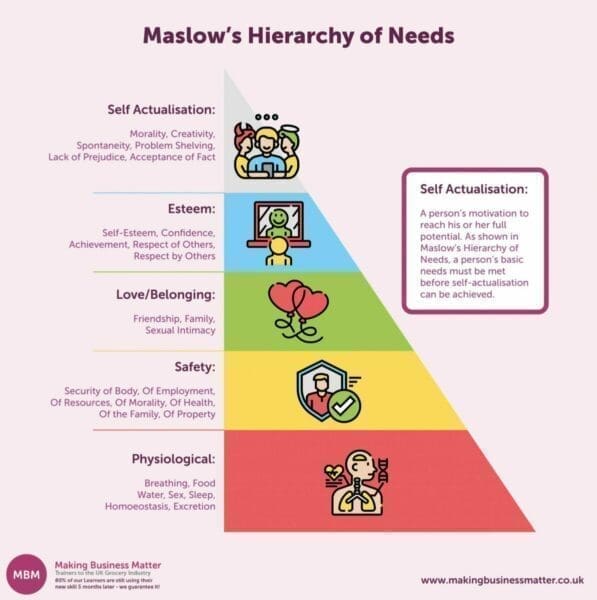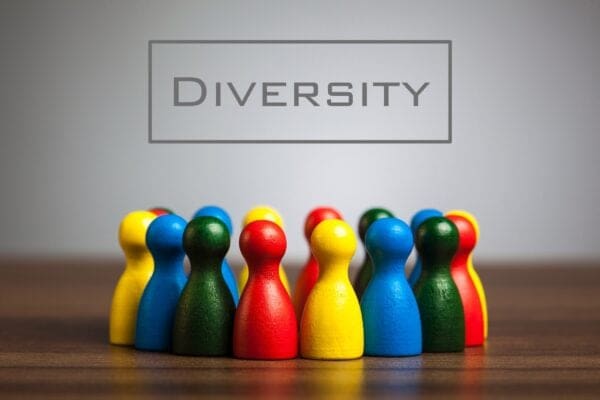Using Tech to Focus on People is the Way Forward
Most businesses will have their HR objectives for 2023 in place by now, as we near the end of the year. For many, the key objective is ensuring competent and willing people are there to do the work. But HR can deliver much more than that.
This article explores how HR objectives will likely change as tech automates much of the drudgery, freeing HR to focus on employee engagement. We consider what remains constant, looking back at an article we posted on HR objectives for 2019. From there, we look ahead to people’s predictions for 2025 and 2030. And we end with a take-out checklist of today’s biggest HR challenges, and how to write a good HR vision statement.
We’re Too Small to Have an HR department, So I Don’t See How This is Relevant!
People usually associate the term ‘HR’ with businesses of a certain size, with departments dedicated to it. But businesses without HR departments also hire, fire and retire people and handle their legal responsibilities as employers. Whether your business is large or small, if you have employees, you have human resources. And you need to manage them.
This is What Typical HR Objectives for a Business Look Like
Longstanding readers of this blog may remember our previous article, Top Human Resource Goals and Objectives for A Successful 2019. Back then Brexit hadn’t happened, and there was no COVID and no Ukraine war. Seen in the rear-view mirror, the world of 2019 seems a far simpler place. The article was written in 2018, and identified these objectives for HR:

- Maintain adequate staffing levels: This is still likely to be the top HR priority in 2023, followed by
- Establish sound hiring and onboarding practices. Along with that, it’s still important to put in place fair and reasonable firing and retirement procedures.
- Make suitable arrangements for business training, either using internal staff or outside specialists like Making Business Matter as appropriate. We said that then, too. Some things don’t change, experts still know best.
- Involve HR in implementing changes: That’s still valid, too. Implementing changes will inevitably impact your people, and as the human resources specialists, you need to safeguard your humans’ wellbeing.
- Improve employee engagement: These days leaders and managers are much more involved in employee engagement than they were a generation ago. That was true in 2018 when we wrote the last article. But business has changed again since the pandemic.
Having held their teams together through the lockdowns, leaders and managers understand much more about servant leadership and inspirational leadership. And in many businesses, the HR function itself has also become agile and nimble. This places HR in a good position to play a strategic role as businesses navigate an uncertain future. And that observation brings us to a fundamental question:
What is the Overall Role of HR Now?
HR departments provide an interface between employers and employees, to the benefit of both sides. Maslow’s Hierarchy of Human Needs works upwards from the most basic requirements. In HR, that means establishing, as Objective #2 just now, proper employment contracts, regular pay and fair terms and conditions.

These essentials also feature in Hertzberg’s list of hygiene factors, things that cause dissatisfaction. They don’t necessarily inspire people to work harder, though if they aren’t buttoned down, it’s demotivating. It’s part of HR’s function to take care of these basics. But HR can contribute much more to a company’s success and, as we’ll see, its role is evolving.
Sticky Learning ® is 7 times more effective than 1-day training courses. Plus, you will get a Chain of Evidence proving your Return on Investment. Discover soft skills training that changes behaviours long term.

So, if Everything’s Changing, What Should a Business’s HR Objectives Be Now?
Here’s another set of HR objectives to consider. One expert says the 4 main objectives of human resource management are these:
- Define an organisational structure that drives productivity.
- Develop effective internal coordination and communication.
- Dedicate time to finding the right staff and developing their skills base.
- Embrace wider societal and ethical developments.
There’s a clear overlap between company objectives and HR objectives. Some experts see HR’s overall objective as ensuring a seamless experience for the company’s people, associated with management and organisational goals. This means supporting a stable work environment, with employee data in one place and efficient supporting operations.
Other experts look at this differently. Some commentators group the main objectives of human resources management under these four headings:
- Societal objectives
- Functional objectives
- Organisational objectives
- Personal objectives
Societal Objectives
The societal objectives of HR involve creating a positive work environment. Hence the ‘societal’ bit. These objectives embrace shaping the work culture. They also cover compliance with the rules and regulations in a particular industry and setting out employee behaviour policies.

Functional Objectives
The functional objectives are the basic HR goals you need to achieve regarding your employees. As we’ve said, the key objective for most businesses is ensuring competent and willing people are available to do the work. This is followed by:
- Easy access to employee data.
- On-time payroll.
- Compliance with current employment regulations.
The first two objectives involve IT. We’ll look at IT’s increasing importance in HR in a moment. In small businesses, it’s likely the boss handles the functional objectives. Or they hand over payroll and the like to the solicitors or the accountants. Either way, there’s a wealth of IT tools available to make HR matters easier for growing businesses.
Organisational Objectives
The organisational objectives of HR support a company’s organisational goals. HR reports to leadership and management teams. Even so, it can be instrumental in helping leaders and managers build a positive work culture. Here are 8 typical HR organisational objectives. Do they apply to your business?
8 Objectives
- Achieve organisational goals: These include workforce handling, staff requirements like hiring and onboarding, payroll management and retirement.
- Work culture: This plays an important part in defining how the human resources management set up works, and in the company’s overall performance. Automating things like leave approvals and reimbursement request acknowledgements is good for the business culture. Speeding up these operations and empowering employees helps create positive vibes at work. So does short and sound onboarding and settling new people in quickly.
- Team integration: Ease communication between line managers and team members over HR-related matters, and use the available tech.
- Training and development: Support managers by providing training and supporting systems and make developing people.
- Employee motivation: Empower employees through simple measures like involvement in company meetings and performance-related appraisals.
- Workforce empowerment: Make it easier for everyone to process leave requests, generate payslips, remaining leave, upcoming holidays and so on. Again, use the tech that’s available.
- Staff retention: Keeping employees retained and motivated is as much a priority for HR as it is for line managers. They need to work as a team.
- Data and compliance: Companies need to be mindful of the current regulations, and make sure they adhere to the reporting requirements.

We often hear about the talent shortage and the difficulty people have recruiting and keeping good staff. Some observers say HR should focus on the employee as a unique individual, driven by human value. That might feel like a bridge too far for some, but there’s wisdom behind it. And this brings us to personal objectives.
Personal Objectives
Consultancy firm EY’s Hendrik Serruys argues that there is a lack of transparency on the part of HR departments. He reckons they should change the approach from company first to employee first and focus on the employee experience. The modern workforce demands room for personal growth and flexibility, says Serruys. This requires a proactive approach to employee experience and satisfaction and a more centralised tech toolset.
So, What Should HR Focus on in 2023?
Clearly, that’s going to differ from company to company. But we can generalise about the top HR trends and priorities. Research firm Gartner carry out regular surveys into all this. In their predictions for 2022, they said HR leaders would concentrate on:
- Building critical skills and competencies.
- Organisational design and change management.
- Current and future leadership team.
- The future of work.
- Diversity, equity and inclusion.
In Gartner’s predictions of the top 5 HR priorities and trends for 2023, the need for leader and manager effectiveness tops the list. Other priorities they mention are much the same; change management, employee experience, recruiting and the future of work. Gartner surveyed over 850 human resources leaders across 60 countries and all major industries. You can download Gartner’s report on their website.
Tech is Set to Transform HR into a Source of Insights to Improve Businesses
Looking ahead to 2025, HR departments will need to understand better how technology is changing to embrace changing industry standards. That’s the Ivy Exec Inc consultancy’s forecast.

It’s clear that automation and innovation are going to drive the future of HR. AI and tech will handle many tedious and time-consuming duties. Observers predict the list including application tracking and review, employee onboarding, learning and development monitoring and employee engagement. We’re already familiar with applying for jobs online, and IT screening applicants. That won’t change.
What is the Future of HR? What Will it Be Like in 2030?
There’ll be more automation, but it won’t be the ‘Rise of the Machines,’ as in Terminator 3! Helped by people analytics, Sage.com predicts by 2030 HR will no longer play a supporting role as it does today Instead it will be part of a business’s strategic core. HR will become a go-to source of insights, helping empower profitability, cost efficiencies and business growth.
Here are 5 trends HRD Connect predict for 2030, that HR leaders, and leaders and managers, need to be aware of:
#1: Revolutionised Employee Experiences That Truly Meet Employee Expectations
Employers are increasingly aware that employees’ expectations for their work extend well beyond pay and compensation. Over half of employees say they want a better work-life balance. Mel Norris-Green, research adviser at CIPD, expects work styles will shift significantly, largely driven by Gen Z. That might be a bit rich for some businesspeople. We keep hearing there aren’t enough home-grown nurses, lorry drivers, bar staff or fruit pickers. Instead, we rely on overseas workers to do these essential jobs. Even so, that’s the experts’ prediction.

#2: HR Leading the Charge on Organisational Flexibility
The pandemic has speeded things up by organisations having to be fluid, resilient and agile. From a response to a crisis, that’s become the norm. From herein, HR leaders’ newfound agility and confidence will enable them to help lead the way in taking companies forward.
#3: Investing in People Analytics to Become a ‘Smart’ Business
This leads on from Sage’s insight. People analytics will offer insights to empower business decision making, say HRD Connect. Currently, 35% of HR leaders don’t believe they have the confidence to provide better insights. And only 28% claim expert analytic skills. Hence the need for the tech.
#4: HR Automation Means Admin Liberation
There’s a new dawn coming, for the 40% of HR leaders who say they’re currently too focused on paperwork and admin. But if today’s economic climate continues, HR may have to fight to get leadership buy-in for the tech investment…
#5: As Gen Z’s Enter the Workforce, Diversity, Equality and Inclusion (DEI) Will be Front and Centre of HR’s Agenda
DEI is a noble attribute for companies to badge themselves with, especially in social media. They fly the flag, and it looks good, but sadly they don’t always deliver on the ground. In many companies, there’s still bias among managers and prejudice against “different” people among employees.
Diversity, Equality and Inclusion Matters, and it’s Becoming More Important

HRD Connect says 70% of jobseekers want to work for companies showing a strong commitment to DEI. It’s being pushed up the agenda as Gen Z’s come into the workplace. They expect employers to take a more serious attitude to it and be flexible and adaptable to change. Tools like people analytics can help HR leaders identify where they need to focus on diversity and related issues, and make changes. But as HRD Connect observe, the only way HR can move the needle on DEI is to be the ones in the business leading the change.
Things to Bear in Mind: The Biggest HR Challenges in 2023
There’s a lot here to think about. As a takeout, today’s biggest HR challenges are widely seen as:
- Employee engagement.
- Supporting leadership and helping them excel.
- Recruiting and onboarding great talent.
- Retaining employees.
- Employee health and wellness.
- Learning and development.
- Adapting to remote working.
- Diversity, equity and inclusion.
- Building a winning culture.
Keep these challenges in your sights, and you won’t go wrong.
And Finally, You Need an HR Vision Statement to Work From
Here are 6 tips to help you create an effective HR vision statement:

- Separate the company’s vision statements (where you want to go) from its mission statements (ie, what you’re currently doing).
- Keep your HR vision statement distinct from the company one.
- ‘SLEEP’ on it: Here’s a helpful acronym to decide what to include:
- Seize the opportunity to recognise great work.
- Look for the best-qualified HR team members.
- Ensure everyone has the right HR tools.
- Establish sound policies.
- Provide competitive salaries.
- Focus on the ‘why’: Encapsulate why you’re doing what you do in a couple of memorable lines. Now you’re on the way to creating a memorable vision statement.
- Easy on the ear, gentle on the mind: Read your vision statement aloud and make sure it sounds good to you. That way, it’s likely to convince others, too.
- Last but not least, make sure your vision statement guides your HR strategy. Encourage your team to refer to it regularly.
Use your vision statement to stay focused, and you’ll get closer to realising your HR objectives in 2023 and beyond.




